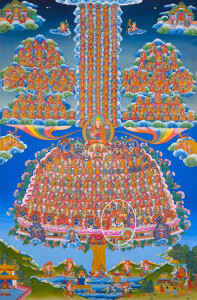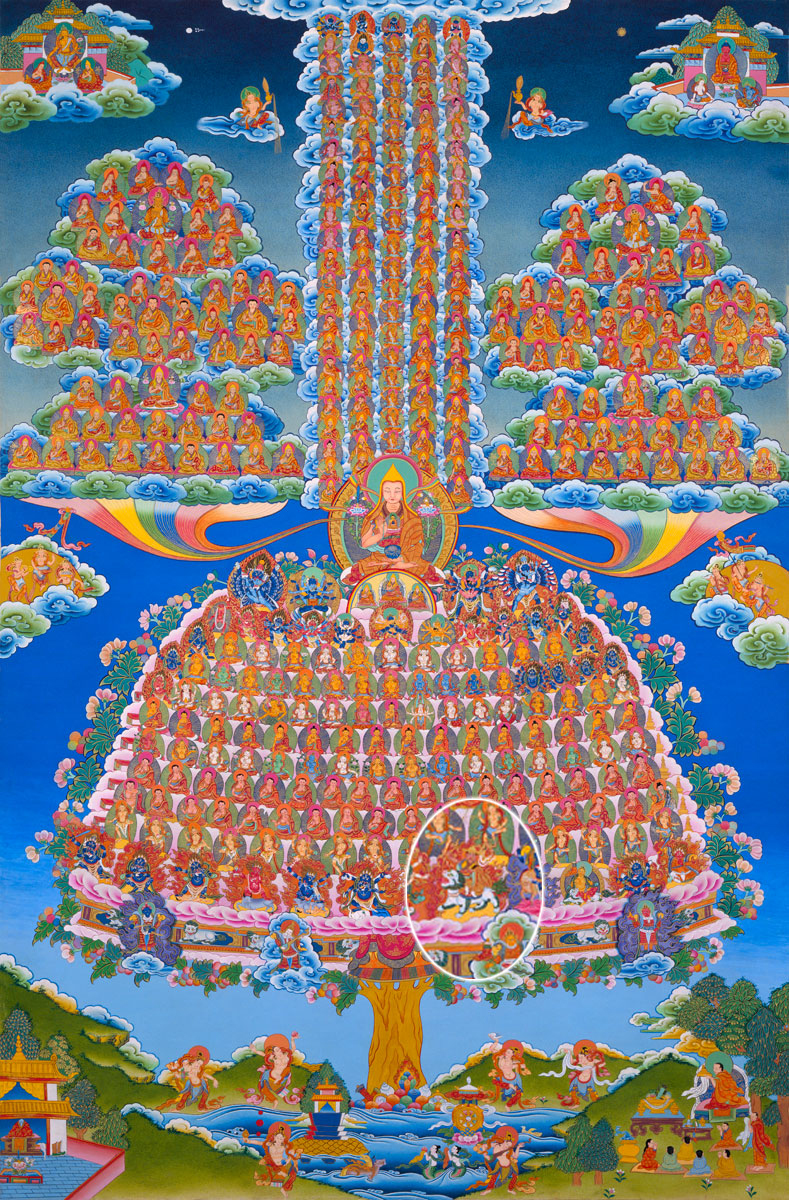[On 6th Dec.2000, His Holiness gave a speech to the participants of ‘The Second International Geluk Conference’ held at Dharamsala. The following is an excerpt from that speech.]

As far as Dolgyal is concerned, we have to look into to find out since when he came to be called the Dharma protector of the gentle Lord Tsongkhapa, and who actually gave him this name. We also need to find out if he has been entrusted with the responsibility by a genuinely reliable master or not. He was not entrusted with the responsibility by Kyabje Phabongkha Rinpoche. At the time Phabongkha Rinpoche was planning to receive one of the Nyingma teachings called The Bounteous, Excellent Vase, he experienced Dolgyal’s conjuring hex when he was shown a blood soaked hand. Terrified, he abandoned the thought of receiving the teachings of The Bounteous, Excellent Vase. This is not a good thing. The previous Rikya Rinpoche used to propitiate Dolgyal quite overtly. At that time, I was also propitiating Dolgyal. I remember Rikya Rinpoche once speaking to me about Dolgyal in a hyperbolic manner. He told me thus: “This Dharma protector is different from others; it picks up the most prominent ones amongst the aristocrats and the top ones amongst Lamas and Geshes.” Later, his household or Labrang forsook Dolgyal’s practice completely. His attendant told me that the fact that the previous Rikya Rinpoche propitiated Dolgyal was not for any good reason, but because as a child he often experienced Dolgyal’s hexes. Once when he felt sick, for fear of Dolgyal’s wrath, he began propitiating him. Isn’t that pitiable?
As far as worldly protectors are concerned, although they should be bound by oath and made to protect the Dharma by qualified Lamas, it appears that those Lamas seemed to have propitiated Dolgyal for fear of his sorceries. It was not a case of controlling the spirit and compelling him to commit, but on the contrary, it was Dolgyal who forced himself upon them. Real solemnisation and appointment of a protector happens when a Lama with high realisation overpowers a devilish spirit, who has no fear or intent for taking precaution, and seeing good purposes in it, forces the spirit to commit and entrust it with the responsibility of safeguarding the Dharma. Thus, real endorsement happens when the Lama gains absolute control over the spirit’s life.
Since when did people start calling him a ‘protector of Tsongkhapa’s doctrine’? Who could have initiated that? No Gaden Tripa bestowed this title on him. None of the past Gyalwa Yabses [The Dalai Lamas and the Panchen Lamas] had given him that title and status. Did anyone from Domed Tashi Kyil Monastery honour him with this responsibility or has anyone from Chamdo Monastery done that? In the past, even the name Shugden was not known to these two major seats.
It is also clear that none of the past Tongkor Rinpoches of Chamdo had honoured him with this title. My brother Taktse Rinpoche had held the throne of Kumbum Monastery for several years. He told me that he had never heard of the name Dolgyal or Shugden while he was there. Anyhow, if you find out how Dolgyal came into being, it was never associated with anything auspicious.
Here, I want to share with you something that Kyabje Trijang Rinpoche shared with me. My tutor Kyabje Trijang Rinpoche and the previous Karmapa Rinpoche were very close friends. Once it happened that while Kyabje Trijang Rinpoche was about to begin his monthly ritual of Fulfillment and Revival or ‘Dakang’ of Shugden with all ritual offerings and others well prepared, he got word that Karmapa Rinpoche was on his way to visit him. Trijang Rinpoche then told me that he had to rush into things and that he had to be very quick. When I asked him what could have made him that hasty, Trijang Rinpoche replied that as Karampa was not fond of Choekyong [Shugden], he had to rush into to remove all the ritual cake offerings from the altar.
Now, looking back at that incident, wasn’t that a bit odd hiding Dolgyal from a Kagyu Lama? If indeed he were a Geluk protector, what was there to hide? For Gelukpas, we have Mahakala and Dharma Raja as protectors of Tsongkhapa’s tradition. Had Karmapa visited at a time when any ritual of either of them was being performed, he would have definitely participated in the ritual, invoking them for swift actions and praising them for achievements. The point that I want to make here is, any protector bound to oath by Lama Tsongkhapa himself and propitiated by Gelukpas would be worth showing off to any Kagyupa or any Nyingmapa who practises Zogchen. Wouldn’t that be shameful and sad if you have to conceal your own Dharma protector?
Kyabje Phabongkha Rinpoche, Kyabje Trijang Rinpoche and Zong Rinpoche had all propitiated and propagated Dolgyal. However, I doubt if this part of their activities had done any good for the Geluk tradition on the whole. From then onwards, there started a period of rising criticism and dislike for the Geluk tradition. There was not a single instance of benefit that this practice had brought about for the study and practice in the great monastic seats. If it were beneficial, then, the previous Denma Lochoe Rinpoche and Gen Tonpon Rinpoche who were such erudite masters of Drepung Monastery would have hailed Dolgyal with praises. On the contrary, one hears stories of their aversion towards Dolgyal’s practice. Also, it was not the case that those who propitiated Dolgyal were better at monastic discipline and study than others who did not. In gist, as far as their activities on Dolgyal are concerned, I feel both Kyabje Phabongkha and Trijang Rinpoche had made mistakes. Their specific activities in connection with Dolgyal are inconsistent with the mainstream practice of Buddhism, and they both had made a mistake.
However, their other activities and practices — which were generally consistent with the mainstream of Buddhism and specifically with Tsongkhapa’s tradition — such as their practice of Lamrim and mind training instructions and their contribution to Tantra — particularly the Chakrasamvara Tantra — by means of teaching, preserving and proliferating them could never be criticised by anyone. In this regard, we all remain indebt to them.
In Haribadhra’s commentary on Maitreya’s Ambhisamaya Alamkara called Illuminating the Meaning, it says thus:
“Vasubandhu, one who is the root of wellbeing of sentient beings,
By relying on his own intuitive inclination,
Had emphatically interpreted phenomena
As being merely conceived internally.
The one who belongs to the assemblage of superior beings,
And known by the name of Vilmuktiksena,
Seeing the said interpretation as invalid,
Interpreted it by his mind that abides in the middle.
Thus, Arya Vilmuktiksena interpreted Abhisamaya Alamkara [Ornament of Clear Realisation] in line with the Middle-Way philosophical school, in sharp contrast to his own master Vasubhandu’s interpretation of the text according to the Chittamatra philosophical school [criticising his master’s version and even using a derogatory line, ‘by highly relying on his intuitive inclination’, to discredit his master’s version]. Does this mean we have to conclude that Arya Vilmuktiksena had breached his commitments to his own master? Does this mean that Arya Vilmuktiksena had disrespected his own teacher? No, it was not the case. In the same manner, Dharmamati Survarnadvipa or Lama Serlingpa, the teacher of Atisha, was critical of the latter’s view. However, Atisha used to say that whenever his view was criticised by his teacher, his conviction on it got strengthened. Also, as far as the lineage of epistemology in Buddhism is concerned, we have Archarya Dignaga who pioneered this tradition, and which was continued by Archarya Ishwarsen and Archarya Dharmakirti. Archarya Dharmakirti’s teacher was Archarya Ishwarsen, who had given him permission to rebuke some of his own versions which were not consistent with Archarya Dignaga’s actual intentions. These are means by which we revitalise and maintain the purity of Buddhism. So, even if it is your Lama’s thought, if it is inconsistent with the mainstream of Buddha’s teachings, we have to revert back to the proper intent. If some teachings of a particular master appear to be inconsistent with the actual thought of Buddha’s teachings — be it either due to the karma of their students or because of other purposes — re-correcting it is the tradition known among Buddhist scholarly practitioners. This is how we preserve and protect the teachings from degeneration.
Gungthang Jamphelyang, one of the most respected Geluk scholars says thus:
“Alas, although this virtuous tradition [of Tsongkhapa]
Is progressing with grandness and wealth,
Thinking how weak it is in learning and practice
Makes my mind slip away from the heart.
Although rare it is to find someone who can teach accurately
The quit essentials of the profound and extensive teachings [of the Buddha],
That your impeccable volumes are still accessible
Relieves my sorrows and gives respite as they still disseminate the supreme gift [of enlightenment].”
In the first stanza, Gunthang Rinpoche expresses his sadness at the critical condition of Tsongkhapa’s tradition. However, in the second stanza he consoles us that Tsongkhapa’s impeccable works are still well preserved for us to access. Je Tsongkhapa studied rigorously, contemplated and meditated on them without falling into extremes. Born out of his genuine conviction on the real intents of the Buddha’s doctrines are his extensive treatises of commentaries that explicitly unravel his impeccable understanding. These works are very much alive and accessible; it’s only a matter of whether we look into them or not, or contemplate on them and meditate on these works that are so easily accessible for us to put into practice. I feel this is the meaning of his expression, ‘that your impeccable volumes are still accessible relieves my sorrows and gives respite as they still disseminate the supreme gift [of enlightenment]’.
On the part of the teachers in the big monastic seats and elsewhere, when you teach Tsongkhapa’s work such as his commentary on Madyamika Karika, it would be good if you are well versed in the root text of Madyamika Karika and its auto-commentary, and then look at Tsongkhapa’s interpretation. In this way, if you teach his Explicitly Illuminating of the Intents of Entering the Middle with total understanding of the root and the auto-commentary, I feel that it will make a stark difference. Also, when you teach Nagarjuna’s ‘Fundamental Wisdom’, it would be good if you first develop a familiarity with Chandrakirti’s ‘Commentary on the ‘Fundamental of Wisdom’ called Illuminating the Words, and Buddhapalita’s commentary to it [that has the same name ‘Buddhapalita’ as its author. Buddhpalitha literally means ‘nurtured by the Buddha’].
Then if you teach by relying on Tsongkhapa’s commentary that draws from these two most famous commentaries of Indian masters, I am sure it will make a huge difference. In this way, if you could teach Madhyamika, just as it is said that Madhyamika Karika engages with the Fundamental of Wisdom through the two means of profundity and extensiveness, by using Tsongkhapa’s commentaries as keys, we can also engage with the Fundamental of Wisdom by internalising its profundity [through one’s own understanding of emptiness] and vastness [by complementing it with the teachings of extensiveness from Ratnavali and other texts of Nagarjuna].
Thus, we would come very close to the views of Nagarjuna, triggering emotions of devotion in you the moment Nagarjuna’s name is mentioned. If this happens, although I do not claim to have any experience or attainment, it propels in me faith in Nagarjuna from the very depth of my heart the moment I hear or think of Tsongkhapa’s assertion ‘the suchness of dependent origination by means of mere conditions’. When faith in Nagarjuna arises, then as I contemplate on his words —
‘Enthused by immense compassion,
In order to dispel all the [distorted] views,
He taught the sublime Dharma.
To that Gautama Buddha, I bow down’—
and consider that such a great master as Arya Nagarjuna praised Buddha Shakyamuni for teaching dependent origination on his own independently, it really moves me to think ‘yes, this definitely is the case’ and motivates me to commit myself to become a genuine follower of Lord Buddha. So, as you teach Tsongkhapa’s commentaries, you should try to look into how he interpreted and clarified technical points by relying on and citing from Arya Nagarjuna’s works. This, I think, is crucial.
The reason why we are gathered here is to make a difference and bring about conviction. For that to happen, it is important to know the facts from history. Although it took some time, I nevertheless thought it important to explain with elaboration. Many of you are already aware of the points I have just mentioned, there are many others from different places who have gathered here. So, I think it is worthwhile if you [from other places] keep my words in mind.
Based on reasons such as those explained above, your judgment about Dolgyal should not be based solely on the Dalai Lama’s words; neither should your assertions abide by the Dalai Lama’s words blindly. This is not correct. The Dalai Lama’s words should not be considered like a sword thrown into the air [that decides things based on wherever it lands].
Treating my words in this way not only contradicts with democracy, but is inconsistent with the general approach of Buddhism. Without being biased, you should investigate and decide. With [Kyabje Phabongkha Rinpoche,] Kyabje Trijang Rinpoche, Zong Rinpoche and others on one side, and with Phurchok Ngawang Jampa, Trichen Ngawang Chokden, Changkya Rolpai Dorji, Yongzin Yeshi Gyaltsen etc. on the other, if you analyse very thoroughly, you will definitely have doubts [about Dolgyal]. There is no way you can remain oblivious to whatever the fact is.
Also, as far as Dagpo Jamphel Lhundrup, the root Guru of Kyabje Phabongkha Rinpoche is concerned, although he may have done some ritual of swift action in connection with Dolgyal, he never considered Dolgyal as something holy and special. We hear from sources that there were two monasteries he was especially connected with. The one in which he lived never propitiated Dolgyal, whilst the other did. Once, there was an issue on whether the monastery in which he lived should propitiate Dolgyal or not, when Dolgyal had somehow made his way into the monastery. Dakpo Rinpoche insisted that they could not keep Dolgyal inside the monastic compound, and kept him outside. We have to consider all these events and investigate further.
If you are someone who would choose to examine [instead of believing in things blindly] we have to consider Nechung’s words on the authenticity of Takphu Rinpoche’s pure vision, which is considered by many as an important validation supporting Dolgyal as an emanation of Dulzin Dakpa Gyaltsen. As Nechung stated, it is quite clear that the pure vision must have been an obstacle. Ling Rinpoche once told me that Kyabje Phabongkha Rinpoche himself shared with him how Takphu Rinpoche had instructed him to examine and edit his work, and how Phabongkha Rinpoche had to extract some teachings particular to the Bon religion of Tibet from Takphu Rinpoche’s works. [Rinpoche seemed to have composed them at the insistence of some of his Bon students.] While investigating on this issue thoroughly, you may forget about the three hundred year old Gaden Phodrang [Tibetan Government] and the 5th Dalai Lama who embraced an ecumenical non-sectarian practice, but think of the other eminent Lamas who were totally opposed to Dolgyal. Phurchok Ngawang Jampa, the principle student of Je Drupkhang Gelek Gyatso, a very learned and an accomplished being, was inconceivably a great custodian of Lamrim. All of them were Lamas who had much concern and love for the Geluk tradition. Look into how these great masters had treated Dolgyal. Things will become clear once you give it a proper thought.



